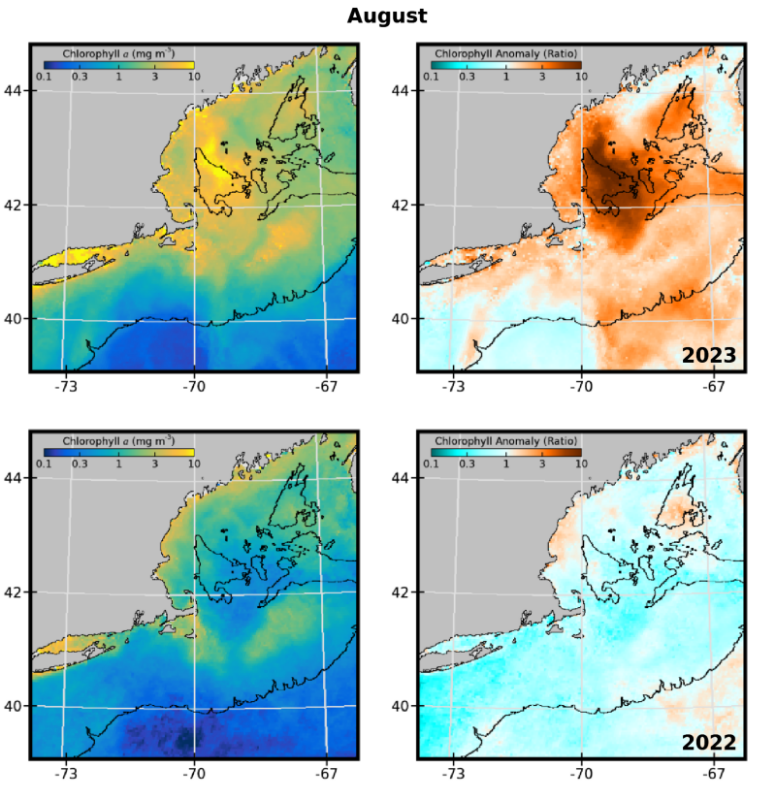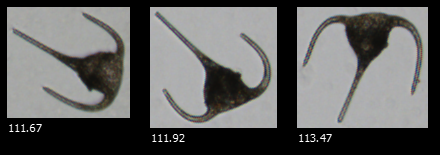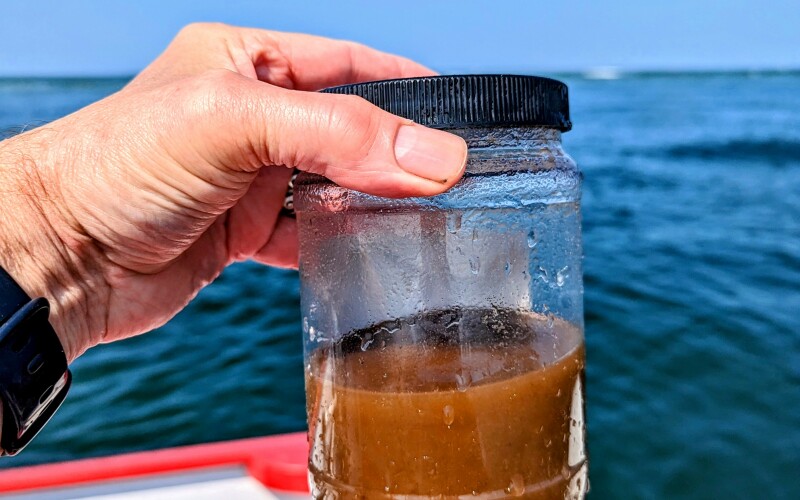Scientists are monitoring an unusually large and long-lived algae bloom extending more than 100 miles across the Gulf of Maine – and keeping a close watch for any signs that the phytoplankton could trigger low-oxygen conditions in New England waters.
Researchers at the University of New Hampshire said Wednesday that they and partners in the region formed a network for measuring and monitoring the brown, coffee-colored bloom, consisting mostly of the dinoflagellate phytoplankton Tripos muelleri drifting in the water column under the surface.
The species is not unusual in New England waters and does not produce a toxin or present any other known risks to humans or animals, according to experts with the Woods Hole Oceanographic Institute’s Harmful Algal Bloom observing network. “However, high biomass blooms like this one have the potential to cause low oxygen conditions when they decay,” according to a summary released by UNH researchers.
“This can negatively affect marine organisms, particularly ones inhabiting bottom waters and sediments.”
The bloom is notable because this is the first time Tripos muelleri has been seen at such high concentrations in summer in the Gulf of Maine. It first got the attention of UNH scientists in April when they noticed significant changes in the ocean carbon dioxide (CO2) and pH levels they regularly monitor off the coast of New Hampshire.
“We were seeing the lowest CO2 levels and highest pH levels in surface water that we have observed in our twenty years of monitoring samples in the Gulf of Maine,” Doug Vandemark, a research professor at UNH’s Ocean Process Analysis Laboratory, said in the UNH statement. “We thought it might be related to the warming water in the Gulf of Maine, and then we started to hear reports about marine filters being clogged with brown algae and other general nuisances from people working along the coast. We knew it wasn’t a coincidence.”

While the phytoplankton bloom species is not known to be dangerous, the event was so unusual that the UNH researchers began additional water samples to increase their monitoring, including phytoplankton counts, eDNA, nutrients, and carbon analyses.
Meanwhile, they began to hear reports from other local scientists, marine operators, and fishermen who were seeing the same unusual conditions throughout the Gulf of Maine. Together, they assembled an informal consortium to share observations and data, now with over a dozen partners from Maine to Rhode Island.
A partial list includes researchers at the National Oceanic and Atmospheric Administration (NOAA), Woods Hole Oceanographic Institution (WHOI), University of Maine, St. Joseph’s College of Maine, University of Massachusetts, Gulf of Maine Research Institute, Bigelow Laboratory for Ocean Sciences and the Northeastern Regional Association of Coastal Ocean Observing Systems (NERACOOS).

“In general, seasonal blooms are a normal occurrence in high latitude marine ecosystems like the Gulf of Maine and are beneficial because the tiny plants provide food for animals and energy that fuels the ocean food web,” according to the UNH team.
“It’s completely normal to see this species in the waters of the Gulf of Maine but never at this intensity,” said Liz Harvey, an associate professor of biological sciences. “At first it was intriguing but then it was larger than any of us had seen before, and we thought, “Wait, this is different” – and as researchers we want to understand the how and why and if it is a signal of a potentially changing Gulf of Maine.”
“High levels of phytoplankton seen in the spring usually decline in the summer months when nutrients that fuel the growth of phytoplankton decrease and animal populations like copepods, or small crustaceans, graze on them helping to reduce the bloom,” according to the UNH narrative. But the 2023 bloom has not followed the usual pattern.
According to satellite imagery by NOAA, the bloom has steadily persisted since April and has been widespread, from Penobscot Bay, Maine, to Martha's Vineyard. It’s not clear why it has lasted so long and over such a widespread area. Scientists are considering possible triggers that may have happened, including lower wind speeds in the spring, a mild winter, and the Gulf of Maine’s long-term climate trend os being one of the fastest-warming regions in the world. Heavy rainfalls in New England this summer may be another factor.
“We’re still looking for answers and there is more work to do,” said Chris Hunt, research assistant professor at UNH’s Ocean Process Analysis Laboratory. “We’ve documented the massive growth of this species and the resulting changes in oxygen, CO2, and pH, but we are all still working to figure out what the conditions were that triggered this bloom in the first place, allowed it to last for so long and what happens to all the cells and organic matter once the bloom is over?”
The research consortium is continuing to collect more water samples in the region over the coming months. In August, recent data showed the bloom may be fading near shore, but the group is working to determine if the decline is also happening farther offshore.
The scientists are also watching closely for any signs of hypoxia, the low-oxygen conditions that can affect marine life. As the phytoplankton begins to fade, or die off, they sink to the bottom of the ocean and are consumed by bacteria, which can deplete oxygen and could have an effect on fish, shellfish, and lobster.
The UNH team noted the last time a big bloom had that effect was during an infamous “brown tide” in 1976 across the New York Bight, when water oxygen levels collapsed and killed off fish and shellfish.
“It is too soon to tell if this Tripos muelleri bloom might lead to a hypoxia event similar to the one in 1976,” said Vandemark. “What is important now is that we continue to monitor into the fall and then try to understand the bloom, any possible impacts and if we could expect more like it in the future.”
The ongoing efforts to collect data includes UNH, joined by several other regional institutions that regularly collect water samples, to analyze key indicators like water temperature, salinity, chlorophyll, nutrients, CO2, and pH levels; continued tracking of the bloom by using satellite imagery of chlorophyll concentrations from NOAA; oxygen sensors on lobster traps deployed by commercial fishermen participating in the eMOLT program; and the collection of phytoplankton, zooplankton, nutrients, oxygen and carbon samples across the Gulf of Maine by NOAA’s NEFSC Ecosystem Monitoring surveys. The group of scientists will continue to monitor conditions over the next few months and are planning to meet as a working group in the fall to analyze all the data.
Support for UNH Gulf of Maine monitoring is provided by the Gulf of Maine Marine Biodiversity Observation Network, led by NERACOOS and the University of Maine which is funded by NOAA and the Bureau of Ocean Energy Management. Additional support is provided by NOAA’s Ocean Acidification program and the Office of Naval Research.








